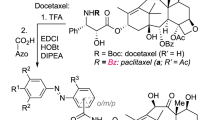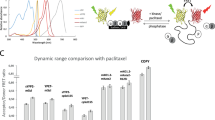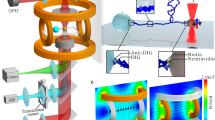Abstract
Decisions on the fate of cells and their functions are dictated by the spatiotemporal dynamics of molecular signalling networks. However, techniques to examine the dynamics of these intracellular processes remain limited. Here, we show that magnetic nanoparticles conjugated with key regulatory proteins can artificially control, in time and space, the Ran/RCC1 signalling pathway that regulates the cell cytoskeleton. In the presence of a magnetic field, RanGTP proteins conjugated to superparamagnetic nanoparticles can induce microtubule fibres to assemble into asymmetric arrays of polarized fibres in Xenopus laevis egg extracts. The orientation of the fibres is dictated by the direction of the magnetic force. When we locally concentrated nanoparticles conjugated with the upstream guanine nucleotide exchange factor RCC1, the assembly of microtubule fibres could be induced over a greater range of distances than RanGTP particles. The method shows how bioactive nanoparticles can be used to engineer signalling networks and spatial self-organization inside a cell environment.
This is a preview of subscription content, access via your institution
Access options
Subscribe to this journal
Receive 12 print issues and online access
$259.00 per year
only $21.58 per issue
Buy this article
- Purchase on Springer Link
- Instant access to full article PDF
Prices may be subject to local taxes which are calculated during checkout





Similar content being viewed by others
References
Kholodenko, B. N., Hancock, J. F. & Kolch, W. Signalling ballet in space and time. Nature Rev. Mol. Cell. Biol. 11, 414–426 (2010).
Kinkhabwala, A. & Bastiaens, P. I. Spatial aspects of intracellular information processing. Curr. Opin. Genet. Dev. 20, 31–40 (2010).
Karsenti, E. Self-organization in cell biology: a brief history. Nature Rev. Mol. Cell. Biol. 9, 255–262 (2008).
Chiang, K. P. & Muir, T. W. Systems- and molecular-level elucidation of signaling processes through chemistry. Sci. Signal 1, pe45 (2008).
Ellis-Davies, G. C. Caged compounds: photorelease technology for control of cellular chemistry and physiology. Nature Methods 4, 619–628 (2007).
Grunwald, C. et al. In situ assembly of macromolecular complexes triggered by light. Proc. Natl Acad. Sci. USA 107, 6146–6151 (2010).
Toettcher, J. E., Voigt, C. A., Weiner, O. D. & Lim, W. A. The promise of optogenetics in cell biology: interrogating molecular circuits in space and time. Nature Methods 8, 35–38 (2011).
Wu, Y. I. et al. A genetically encoded photoactivatable Rac controls the motility of living cells. Nature 461, 104–108 (2009).
Levskaya, A., Weiner, O. D., Lim, W. A. & Voigt, C. A. Spatiotemporal control of cell signalling using a light-switchable protein interaction. Nature 461, 997–1001 (2009).
Lim, W. A. Designing customized cell signalling circuits. Nature Rev. Mol. Cell. Biol. 11, 393–403 (2010).
Doktycz, M. J. & Simpson, M. L. Nano-enabled synthetic biology. Mol. Syst. Biol. 3, 1–10 (2007).
Wilner, O. I. et al. Enzyme cascades activated on topologically programmed DNA scaffolds. Nature Nanotech. 4, 249–254 (2009).
Kiel, C., Yus, E. & Serrano, L. Engineering signal transduction pathways. Cell 140, 33–47 (2010).
Chen, C. S. Biotechnology: remote control of living cells. Nature Nanotech. 3, 13–14 (2008).
Mannix, R. J. et al. Nanomagnetic actuation of receptor-mediated signal transduction. Nature Nanotech. 3, 36–40 (2008).
Lee, J-H. et al. Artificial control of cell signaling and growth by magnetic nanoparticles. Angew. Chem. Int. Ed. 49, 5698–5702 (2010).
Steketee, M. B. et al. Nanoparticle-mediated signaling endosome localization regulates growth cone motility and neurite growth. Proc. Natl Acad. Sci. USA 108, 19042–19047 (2011).
Desai, A., Murray, A., Mitchison, T. J. & Walczak, C. E. The use of Xenopus egg extracts to study mitotic spindle assembly and function in vitro. Methods Cell Biol. 61, 385–412 (1999).
Hannak, E. & Heald, R. Investigating mitotic spindle assembly and function in vitro using Xenopus laevis egg extracts. Nature Protoc. 1, 2305–2314 (2006).
Vetter, I. R. & Wittinghofer, A. The guanine nucleotide-binding switch in three dimensions. Science 294, 1299–1304 (2001).
Vartak, N. & Bastiaens, P. Spatial cycles in G-protein crowd control. EMBO J. 29, 2689–2699 (2010).
Kalab, P. & Heald, R. The RanGTP gradient—a GPS for the mitotic spindle. J. Cell Sci. 121, 1577–1586 (2008).
Carazo-Salas, R. E. et al. Generation of GTP-bound Ran by RCC1 is required for chromatin-induced mitotic spindle formation. Nature 400, 178–181 (1999).
Karsenti, E. & Vernos, I. The mitotic spindle: a self-made machine. Science 294, 543–547 (2001).
Wittmann, T., Hyman, A. & Desai, A. The spindle: a dynamic assembly of microtubules and motors. Nature Cell Biol. 3, E28–E34 (2001).
Clarke, P. R. & Zhang, C. Spatial and temporal coordination of mitosis by Ran GTPase. Nature Rev. Mol. Cell Biol. 9, 464–477 (2008).
Caudron, M., Bunt, G., Bastiaens, P. & Karsenti, E. Spatial coordination of spindle assembly by chromosome-mediated signaling gradients. Science 309, 1373–1376 (2005).
Toyoshima, Y., Kakuda, H., Fujita, K. A., Uda, S. & Kuroda, S. Sensitivity control through attenuation of signal transfer efficiency by negative regulation of cellular signalling. Nature Commun. 3, 743 (2012).
Kaláb, P., Pralle, A., Isacoff, E. Y., Heald, R. & Weis, K. Analysis of a RanGTP-regulated gradient in mitotic somatic cells. Nature 440, 697–701 (2006).
Jimenez, A. M. et al. Towards high throughput production of artificial egg oocytes using microfluidics. Lab. Chip 11, 429–434 (2011).
Pinot, M. et al. Effects of confinement on the self-organization of microtubules and motors. Curr. Biol. 19, 954–960 (2009).
Li, R. & Gundersen, G. G. Beyond polymer polarity: how the cytoskeleton builds a polarized cell. Nature Rev. Mol. Cell Biol. 9, 860–873 (2008).
Halpin, D., Kalab, P., Wang, J., Weis, K. & Heald, R. Mitotic spindle assembly around RCC1-coated beads in Xenopus egg extracts. PLoS Biol. 9, e1001225 (2011).
Gaetz, J., Gueroui, Z., Libchaber, A. & Kapoor, T. M. Examining how the spatial organization of chromatin signals influences metaphase spindle assembly. Nature Cell Biol. 8, 924–932 (2006).
Bastiaens, P., Caudron, M., Niethammer, P. & Karsenti, E. Gradients in the self-organization of the mitotic spindle. Trends Cell Biol. 16, 125–134 (2006).
Athale, C. A. et al. Regulation of microtubule dynamics by reaction cascades around chromosomes. Science 322, 1243–1247 (2008).
Soh, S., Byrska, M., Kandere-Grzybowska, K. & Grzybowski, B. A. Reaction-diffusion systems in intracellular molecular transport and control. Angew. Chem. Int. Ed. 49, 4170–4198 (2010).
Bryant, D. M. & Mostov, K. E. From cells to organs: building polarized tissue. Nature Rev. Mol. Cell Biol. 9, 887–901 (2008).
Good, M. C., Zalatan, J. G. & Lim, W. A. Scaffold proteins: hubs for controlling the flow of cellular information. Science 332, 680–686 (2011).
Bashor, C. J., Horwitz, A. A., Peisajovich, S. G. & Lim, W. A. Rewiring cells: synthetic biology as a tool to interrogate the organizational principles of living systems. Annu. Rev. Biophys. 39, 515–537 (2010).
Grunberg, R. & Serrano, L. Strategies for protein synthetic biology. Nucleic Acids Res. 38, 2663–2675 (2010).
Osterfield, M., Kirschner, M. W. & Flanagan, J. G. Graded positional information: interpretation for both fate and guidance. Cell 113, 425–428 (2003).
Izaurralde, E., Kutay, U., von Kobbe, C., Mattaj, I. W. & Görlich, D. The asymmetric distribution of the constituents of the Ran system is essential for transport into and out of the nucleus. EMBO J. 16, 6535–6547 (1997).
Kutay, U., Izaurralde, E., Bischoff, F. R., Mattaj, I. W. & Görlich, D. Dominant-negative mutants of importin-beta block multiple pathways of import and export through the nuclear pore complex. EMBO J. 16, 1153–1163 (1997).
Pinot, M. et al. Confinement induces actin flow in a meiotic cytoplasm. Proc. Natl Acad. Sci. USA 109, 11705–11710 (2012).
Acknowledgements
The authors thank I. Mattaj and B. Koch for the RanQ69L and RCC1 expression plasmids, K. Weis for the Rango expression plasmid and N. Morin for the Ran(T24N) expression plasmid. The authors also thank F. Guyot, J.M. Guignier and L. Largeau for electron microscopy observations. Thanks also go to F. Grasset, A. Gautier, L. Jullien, T. Le Saux, A. Libchaber, N. Nerambourg, C. Tribet, J. Wu and the members of the Biophysical Chemistry Center of ENS for fruitful discussions. This work was supported by the CNRS, the Association pour la Recherche sur le Cancer (SFI20101201426), the Ligue Nationale Contre le Cancer (LNCC, 2009) and Ville de Paris ‘Emergence’ (to Z.G.), the Agence Nationale de la Recherche (ANR, ANR-08-PNANO-050 to R.LB., V.M., C.G. and Z.G.), FRM, Triangle de la Physique (to E.M.) and ATIP CNRS (to R.LB.).
Author information
Authors and Affiliations
Contributions
C.H. and Z.G. conceived and designed the experiments. C.H., S.L. and Z.G. performed the experiments. E.M. and C.G. performed the simulations. All authors analysed the data. C.G., R.L.B. and V.M. contributed materials/analysis tools. C.H. and Z.G. wrote the manuscript and all authors commented on it.
Corresponding author
Supplementary information
Supplementary information
Supplementary information (PDF 9290 kb)
Supplementary movie S1
Supplementary movie S1 (AVI 9447 kb)
Supplementary movie S2
Supplementary movie S2 (AVI 4726 kb)
Rights and permissions
About this article
Cite this article
Hoffmann, C., Mazari, E., Lallet, S. et al. Spatiotemporal control of microtubule nucleation and assembly using magnetic nanoparticles. Nature Nanotech 8, 199–205 (2013). https://doi.org/10.1038/nnano.2012.246
Received:
Accepted:
Published:
Issue Date:
DOI: https://doi.org/10.1038/nnano.2012.246
This article is cited by
-
Magnetic forces enable controlled drug delivery by disrupting endothelial cell-cell junctions
Nature Communications (2017)
-
Neural recording and modulation technologies
Nature Reviews Materials (2017)
-
Programmed Self-Assembly of a Biochemical and Magnetic Scaffold to Trigger and Manipulate Microtubule Structures
Scientific Reports (2017)
-
Single-cell mechanogenetics using monovalent magnetoplasmonic nanoparticles
Nature Protocols (2017)
-
Remote Actuation of Magnetic Nanoparticles For Cancer Cell Selective Treatment Through Cytoskeletal Disruption
Scientific Reports (2016)



